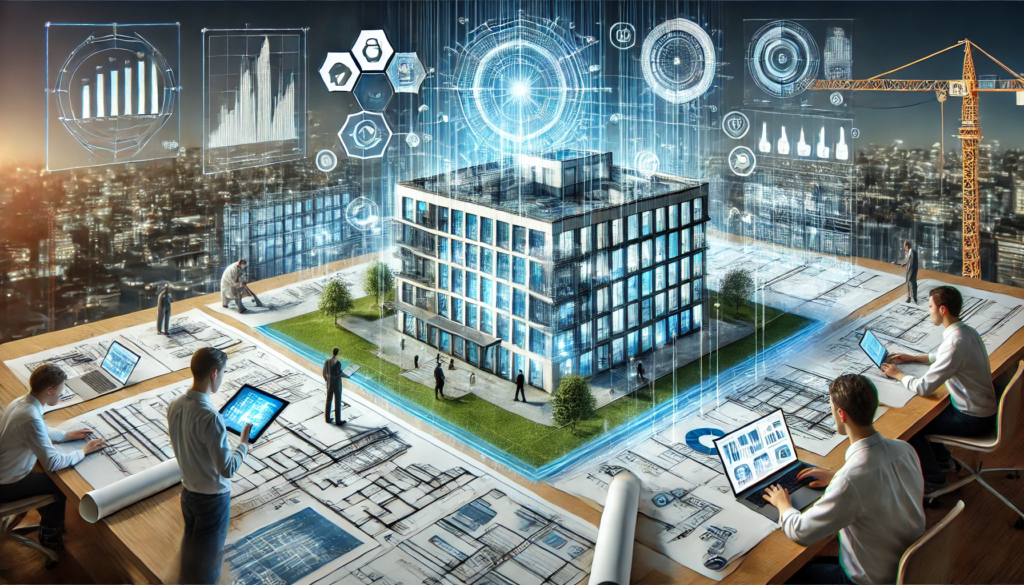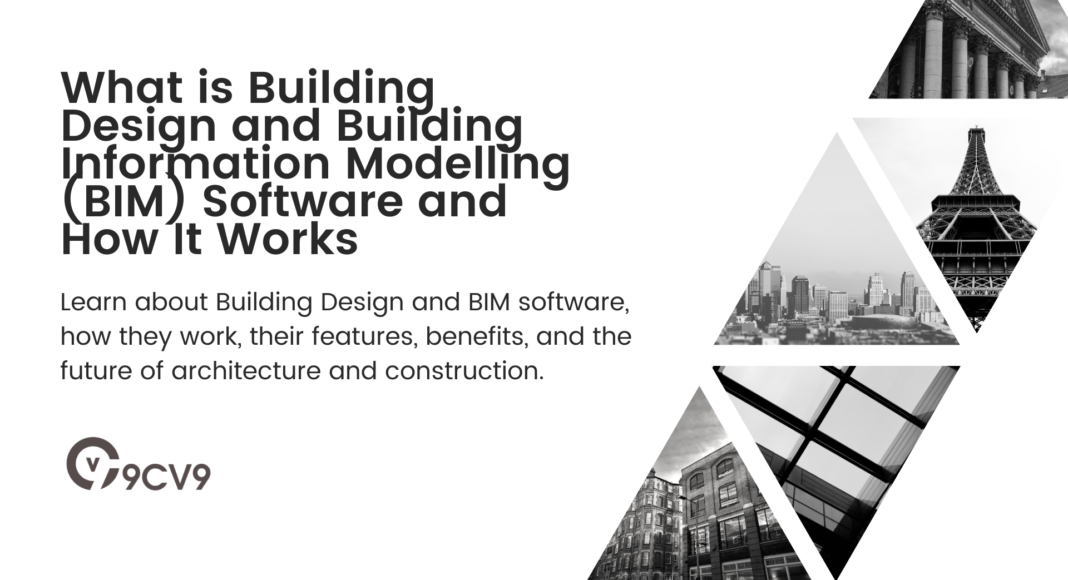Key Takeaways
- Building Design and BIM software integrate design, construction, and management processes for efficient project execution and collaboration.
- BIM enhances design precision, reduces errors, and supports sustainable building practices by simulating real-world conditions.
- As the future of the AEC industry, BIM software incorporates emerging technologies like AI and IoT, further improving building performance and lifecycle management.
The landscape of construction and architecture has evolved significantly over the past few decades, driven by technological advancements that have redefined how buildings are designed, constructed, and managed.
Traditional methods of building design, relying heavily on two-dimensional plans and manual processes, have gradually given way to more sophisticated, data-driven approaches.
Among the most revolutionary of these advancements is Building Information Modeling (BIM) software, a powerful tool that is transforming the entire construction lifecycle from initial design to long-term building operation.

Building design is the blueprint of any construction project, encompassing everything from the layout and appearance of a structure to the materials and systems that make it functional and sustainable.
Historically, architects and engineers worked in silos, relying on static drawings and models that often lacked coordination across disciplines.
This sometimes led to miscommunications, design conflicts, and costly delays during construction.
However, the integration of BIM software has bridged these gaps, allowing for a more collaborative, transparent, and efficient approach to building design.
Building Information Modeling (BIM) refers to a digital representation of both the physical and functional characteristics of a building.
Unlike traditional design methods, BIM integrates every aspect of a building project—architectural, structural, mechanical, electrical, and plumbing—into a unified 3D model.
This model not only provides a more accurate and detailed visualization of the project but also contains data that can be leveraged throughout the project lifecycle, from planning and design to construction, operation, and maintenance.
BIM is more than just a tool for creating 3D models; it is a comprehensive approach to construction management that facilitates better decision-making, enhances collaboration, and reduces risks.
By allowing different stakeholders to interact with the same model in real-time, BIM ensures that design discrepancies are caught early, leading to fewer errors and cost overruns.
It also enables advanced simulations for energy efficiency, sustainability, and structural integrity, making it an essential tool for modern architects, engineers, and builders who seek to deliver high-quality, sustainable, and cost-effective buildings.
In this blog, we will delve deeper into what building design and BIM software are, how they work, and why they have become indispensable tools in the construction industry.
We will explore the key features of BIM software, how it facilitates collaboration, and how it contributes to reducing costs, improving efficiency, and ensuring better outcomes for construction projects.
We will also examine some of the top BIM software tools on the market and highlight their unique features.
Whether you are an architect, engineer, contractor, or building owner, understanding how BIM works and how it can enhance your projects is crucial for staying competitive in the evolving construction industry.
Before we venture further into this article, we would like to share who we are and what we do.
About 9cv9
9cv9 is a business tech startup based in Singapore and Asia, with a strong presence all over the world.
With over nine years of startup and business experience, and being highly involved in connecting with thousands of companies and startups, the 9cv9 team has listed some important learning points in this overview of What is Building Design and Building Information Modelling (BIM) Software and How It Works.
If your company needs recruitment and headhunting services to hire top-quality employees, you can use 9cv9 headhunting and recruitment services to hire top talents and candidates. Find out more here, or send over an email to [email protected].
Or just post 1 free job posting here at 9cv9 Hiring Portal in under 10 minutes.
What is Building Design and Building Information Modelling (BIM) Software and How It Works
- What is Building Design?
- What is Building Information Modeling (BIM)?
- How BIM Software Works
- Key Features of Building Design and BIM Software
- Benefits of Using BIM Software
- Challenges and Considerations in Implementing BIM
- The Future of Building Design and BIM Software
1. What is Building Design?
Building design is the process of conceptualizing, planning, and creating the physical and functional characteristics of a structure. It is a multidisciplinary approach that incorporates architectural, structural, and engineering principles to ensure the final building meets aesthetic, safety, functional, and sustainability requirements. The goal of building design is not only to create a visually appealing structure but also one that is safe, cost-effective, and suitable for its intended use. Effective building design requires collaboration between architects, engineers, contractors, and other stakeholders throughout the entire design and construction process.
Building design is a crucial aspect of the construction process and plays a vital role in determining the long-term success of a building. In this section, we will explore the various components of building design, the factors influencing the design process, and examples of notable building designs that demonstrate the importance of each element.
Key Components of Building Design
Building design is a multifaceted process that incorporates several key components to ensure the building functions properly and meets both user and regulatory needs. These components include:
- Architectural Design
- Defines the building’s overall form, appearance, and layout.
- Focuses on aesthetic qualities, spatial organization, and user experience.
- Considers interior and exterior elements such as facades, windows, doors, and finishes.
- Example: The Sydney Opera House in Australia is a famous example of architectural design, combining innovative forms and functional spaces for world-class performances.
- Structural Design
- Ensures the building can withstand external forces like wind, earthquakes, and gravity.
- Involves the design of the foundation, frame, beams, columns, and load-bearing elements.
- Example: The Burj Khalifa in Dubai, the tallest building in the world, is a masterclass in structural engineering that relies on a reinforced concrete core to support the immense height and load-bearing requirements.
- Mechanical, Electrical, and Plumbing (MEP) Design
- Focuses on the design of essential systems that support building functionality.
- Mechanical design includes heating, ventilation, and air conditioning (HVAC) systems.
- Electrical design addresses wiring, lighting, power supply, and energy efficiency.
- Plumbing design includes water supply, waste management, and drainage systems.
- Example: The Apple Park campus in Cupertino, California, features cutting-edge HVAC and energy-efficient plumbing systems that contribute to its sustainability.
- Landscape Design
- Ensures that the outdoor environment complements the building’s design and functionality.
- Involves the integration of green spaces, outdoor pathways, gardens, and recreational areas.
- Example: The Gardens by the Bay in Singapore is an exceptional example of landscape design, blending nature with architectural structures to create a harmonious public space.
- Sustainability and Environmental Design
- Incorporates eco-friendly practices to reduce the building’s environmental impact.
- Focuses on energy efficiency, sustainable materials, water conservation, and minimizing waste.
- Example: The Bullitt Center in Seattle, often referred to as the “greenest commercial building in the world,” features solar panels, rainwater harvesting, and energy-efficient systems.
Factors Influencing Building Design
Several factors influence building design, and these factors must be considered carefully to achieve a functional and aesthetically pleasing final product. These include:
- User Needs and Functionality
- The building design must accommodate the specific needs of its users, whether residential, commercial, educational, or recreational.
- For example, the design of a hospital must prioritize ease of movement, patient safety, and accessibility, while a school building must ensure flexible spaces for learning and collaboration.
- Building Codes and Regulations
- Building designs must adhere to local and national building codes and safety regulations.
- These regulations ensure that the building meets safety standards, accessibility requirements, fire protection, and structural integrity.
- Example: In many countries, buildings must meet seismic codes to prevent structural failure during earthquakes. The Taipei 101 in Taiwan was designed with a massive tuned mass damper to mitigate the effects of earthquakes and high winds.
- Climate and Environmental Considerations
- Climate plays a significant role in the design process, especially for energy efficiency and environmental impact.
- Buildings must be designed to withstand local weather conditions, such as temperature extremes, rainfall, and humidity.
- Example: The Masdar City in the United Arab Emirates is an example of building design tailored to the extreme desert climate, utilizing passive cooling techniques and solar energy.
- Budget and Project Constraints
- The cost of construction and available budget influence the choice of materials, finishes, and design features.
- Designers must balance aesthetic and functional goals with the project’s budgetary limits.
- Example: The design of the Shenzhen Ping An Finance Center in China, one of the tallest buildings in the world, required careful consideration of both its budget and the complexity of its structure.
- Cultural and Historical Context
- The design of a building must consider its cultural, historical, and geographical context to ensure it blends harmoniously with its surroundings.
- Example: The Colosseum in Rome is an iconic example of ancient building design that reflects the Roman Empire’s engineering prowess while harmonizing with the city’s cultural heritage.
Building Design Process
The building design process is a series of stages, each contributing to the final product. These stages include:
- Conceptual Design
- This initial phase involves brainstorming, sketching, and defining the project’s scope, goals, and vision.
- Architects create rough designs, considering site analysis, functional requirements, and aesthetic preferences.
- Schematic Design
- In this phase, the design team develops a more detailed representation of the building, including floor plans and elevations.
- Key considerations include layout, circulation, and spatial relationships between different areas of the building.
- Design Development
- The design is refined, and technical details are incorporated, such as materials, structural elements, and systems.
- The design team collaborates with engineers to ensure structural integrity and compliance with building codes.
- Construction Documentation
- This phase produces detailed drawings and specifications that guide the construction process.
- It includes final architectural plans, structural calculations, and MEP systems diagrams.
- Construction and Post-Construction
- Once the design is finalized, construction begins. Afterward, post-construction tasks, such as inspections and adjustments, ensure the building meets the original design vision.
Conclusion
Building design is a complex, multidisciplinary process that requires careful consideration of various factors, from user needs and safety regulations to environmental impact and budget constraints. Whether designing a residential home, an office building, or a large public space, the goal is to create structures that are not only functional and safe but also enhance the human experience. By understanding the key components of building design, stakeholders can ensure that each project is executed with precision and creativity, resulting in lasting and meaningful contributions to the built environment.
2. What is Building Information Modeling (BIM)?
Building Information Modeling (BIM) is a revolutionary approach to the design, construction, and management of buildings that involves the creation and utilization of a digital model to represent both the physical and functional aspects of a project. BIM integrates data and design from various disciplines—architecture, structural engineering, mechanical, electrical, and plumbing (MEP)—into one cohesive 3D model. It enhances collaboration, accuracy, and efficiency throughout the project lifecycle, from the initial planning and design stages to construction and long-term facility management.
BIM is not just a tool for drafting; it’s a comprehensive methodology that brings together all stakeholders involved in a project—designers, contractors, engineers, and owners—into a shared digital workspace. This allows for more effective decision-making, improved project outcomes, and reduced costs. In this section, we will delve deeper into what BIM is, its core components, its applications, and how it works to streamline the entire construction process.
Core Components of BIM
BIM involves several core components that work together to create an accurate, comprehensive model of a building. These components include:
- 3D Modeling
- BIM uses 3D models to create a detailed digital representation of a building.
- The 3D model allows stakeholders to visualize the structure from different angles and perspectives, enhancing design accuracy and communication.
- Example: The One World Trade Center in New York City utilized BIM for detailed 3D modeling, ensuring structural integrity and accurate construction sequencing.
- Data Integration
- BIM integrates data related to materials, dimensions, quantities, and project schedules, allowing for better coordination and decision-making.
- The model includes detailed information on every aspect of the building, including systems, costs, and timelines.
- Example: The London 2012 Olympic Stadium used BIM to track material quantities, reduce waste, and improve project scheduling and logistics.
- Collaboration and Coordination
- BIM fosters collaboration by allowing all project stakeholders to access the same model in real-time.
- This collaboration ensures that all disciplines—architecture, engineering, and construction—work together cohesively, minimizing errors and omissions.
- Example: The Marina Bay Sands resort in Singapore used BIM to ensure seamless collaboration between architects, engineers, and contractors throughout the project lifecycle.
- Project Lifecycle Integration
- BIM integrates every stage of the building’s lifecycle, from design to construction to operation and maintenance.
- This allows for continuous updates and modifications to the model as the project progresses, ensuring accuracy at every stage.
- Example: The San Francisco International Airport used BIM for both the design and ongoing operation of its terminals, facilitating long-term asset management and efficiency.
How Does BIM Work?
BIM works by creating a centralized digital model that can be shared and updated by all stakeholders throughout the project. The model serves as the foundation for decision-making, allowing for real-time communication, feedback, and problem-solving. Here’s a breakdown of how BIM works in the construction process:
- Planning and Design
- Architects and engineers create a 3D digital model that includes the building’s layout, dimensions, and systems.
- The model includes detailed data about materials, energy efficiency, structural requirements, and more, enabling designers to assess performance and feasibility.
- Example: In the design of The Shard in London, BIM enabled architects and engineers to optimize the building’s design for energy efficiency and structural integrity, as well as to visualize the impact of sunlight and shadows on the surrounding area.
- Construction Coordination
- Contractors use the BIM model to plan and coordinate construction activities, ensuring that materials and resources are delivered on time and to the correct specifications.
- BIM is used for clash detection, which identifies and resolves potential conflicts between building systems (e.g., plumbing and HVAC) before construction begins.
- Example: The Dubai Opera House utilized BIM to coordinate construction efforts across multiple teams, reducing construction delays and improving safety.
- Facility Management and Operations
- After construction, the BIM model becomes an invaluable tool for ongoing facility management.
- The model includes detailed information about the building’s systems and components, making it easier to manage maintenance, upgrades, and repairs over time.
- Example: The Louvre Abu Dhabi museum uses BIM to manage its HVAC systems, lighting, and general maintenance, optimizing energy use and reducing operational costs.
Benefits of BIM
The adoption of BIM offers numerous benefits throughout the project lifecycle. Some of the most significant advantages include:
- Improved Collaboration
- BIM enables better communication between all project stakeholders, ensuring that everyone works from the same model and that changes are automatically updated.
- This reduces misunderstandings, discrepancies, and conflicts during construction.
- Example: The Hong Kong International Airport Terminal 2 used BIM for real-time collaboration between architects, engineers, and contractors, improving the efficiency of the construction process.
- Enhanced Design Accuracy and Visualization
- The 3D model offers a highly accurate representation of the final building, allowing stakeholders to better visualize the design and make informed decisions.
- The ability to simulate different scenarios, including lighting, environmental factors, and structural performance, allows for more precise planning.
- Example: The Walt Disney Concert Hall in Los Angeles used BIM to simulate acoustics, ensuring optimal sound quality before construction began.
- Cost and Time Savings
- BIM helps reduce errors, rework, and costly delays by allowing for detailed planning and clash detection before construction begins.
- The ability to plan and coordinate more effectively results in cost savings and more efficient project timelines.
- Example: The Sydney Opera House used BIM to streamline the construction process, saving both time and money while meeting design expectations.
- Better Resource Management
- BIM allows for better management of materials, labor, and other resources by providing real-time data on inventory, delivery schedules, and labor requirements.
- This improves efficiency and reduces waste during the construction process.
- Example: The Beijing National Stadium (Bird’s Nest) employed BIM for resource management, minimizing material waste and optimizing construction logistics.
- Sustainability and Energy Efficiency
- BIM supports the design of sustainable buildings by enabling designers to simulate energy consumption and assess the building’s environmental impact.
- It can help identify opportunities for energy savings, better insulation, and environmentally friendly materials.
- Example: The Empire State Building used BIM to improve energy efficiency through better HVAC design, reducing overall energy consumption and operating costs.
Applications of BIM Across the Industry
BIM’s impact extends beyond just the architectural and construction industries; it is widely used across various sectors, including urban planning, infrastructure development, and facility management. Some key applications of BIM include:
- Architecture
- Architects use BIM to create detailed building designs, visualize architectural elements, and optimize the overall layout and functionality of spaces.
- Example: The Guggenheim Museum in New York used BIM to redesign and optimize its complex forms, ensuring both aesthetic beauty and structural stability.
- Construction Management
- Construction managers use BIM for project scheduling, material management, and construction coordination.
- BIM enables construction teams to plan more efficiently and monitor progress in real-time.
- Example: The Sagrada Familia in Barcelona used BIM to streamline construction planning and avoid conflicts between various trades.
- Facility Management
- After construction, BIM plays a key role in building operation and maintenance. Facility managers use BIM to access data on building systems and components, making repairs, upgrades, and energy management more efficient.
- Example: The Shanghai Tower uses BIM to manage its extensive building systems and ensure optimal performance and sustainability throughout its lifecycle.
Conclusion
Building Information Modeling (BIM) is more than just a digital tool; it is a transformative approach to building design and construction that promotes collaboration, reduces errors, and enhances efficiency. From the initial planning stages to the long-term operation and maintenance of a building, BIM plays a central role in shaping modern architecture and construction practices. By integrating 3D modeling with comprehensive data management, BIM improves project outcomes, reduces costs, and creates more sustainable, high-performance buildings. As the construction industry continues to evolve, BIM will remain at the forefront of innovation, empowering professionals to deliver smarter, more efficient, and environmentally conscious buildings.
3. How BIM Software Works
Building Information Modeling (BIM) software is an advanced tool used to create, manage, and share 3D digital models of building projects. This software enables architects, engineers, contractors, and facility managers to collaborate effectively, reduce errors, improve efficiency, and ensure better decision-making throughout the entire project lifecycle. The way BIM software works can be broken down into several key processes, from data integration and 3D modeling to coordination, simulation, and project management. In this section, we will explore how BIM software functions, its key features, and how it benefits each stage of the construction process.
Key Processes in How BIM Software Works
BIM software streamlines the design and construction processes by creating a shared, interactive environment where all stakeholders can access real-time information. The software’s ability to integrate, manage, and visualize all aspects of a building project is what makes it so powerful.
1. 3D Modeling and Design Creation
- Design Representation
- BIM software creates a comprehensive 3D model of the building, including architectural, structural, mechanical, electrical, and plumbing (MEP) systems.
- The model represents the physical structure as well as the functional aspects, including the interaction between different building systems.
- Example: The Burj Khalifa in Dubai leveraged BIM to create detailed 3D models, ensuring precision in the design and integration of its complex systems.
- Parametric Design
- In BIM, elements of the building are represented as parametric objects that can be manipulated based on specific design parameters (e.g., height, width, volume).
- Any changes made to one part of the model automatically update other related components, ensuring consistency and reducing the risk of errors.
- Example: The Beijing National Aquatics Center used parametric design features to achieve the building’s unique curvilinear shape and efficient structural design.
2. Data Integration and Centralized Database
- Comprehensive Data Storage
- BIM software stores not only the design elements but also vital project data such as material specifications, cost estimates, energy performance, and schedule details.
- This data is embedded into the 3D model and is accessible to all stakeholders, allowing them to make informed decisions at every stage of the project.
- Example: The One World Trade Center in New York used BIM’s data integration to track materials, energy use, and design changes to ensure smooth project management.
- Real-Time Updates
- The centralized nature of the BIM model ensures that any changes made by one stakeholder are reflected in real-time across all instances of the model.
- This ensures that everyone is working from the most up-to-date version, preventing inconsistencies and miscommunication.
- Example: During the construction of The Shard in London, BIM allowed project teams to access real-time updates on materials, schedules, and designs, improving coordination and workflow.
3. Collaboration and Communication
- Multi-Disciplinary Coordination
- BIM software enables collaboration between architects, engineers, contractors, and other professionals involved in the project.
- Each discipline works within the same platform, allowing for better coordination and faster problem resolution.
- Example: The Marina Bay Sands resort in Singapore used BIM to facilitate collaboration between architects, structural engineers, and MEP engineers, ensuring the successful integration of all design elements.
- Clash Detection
- BIM software can automatically detect conflicts or “clashes” between different building systems, such as structural elements conflicting with HVAC systems.
- Early detection of clashes prevents costly rework during construction and ensures that the final design is feasible.
- Example: During the construction of Heathrow Terminal 5, BIM’s clash detection feature helped identify potential conflicts, significantly reducing construction delays.
4. Simulation and Analysis
- Energy and Sustainability Analysis
- BIM software can simulate various environmental factors to optimize building performance.
- Energy simulations help assess a building’s energy use, heating, cooling, and lighting requirements to ensure efficiency and sustainability.
- Example: The Edge in Amsterdam, a sustainable office building, used BIM software to optimize its energy performance, achieving a BREEAM Outstanding rating for sustainability.
- Structural and Performance Simulation
- BIM allows for structural analysis, ensuring the building can withstand environmental stresses, including wind, seismic activity, and weight distribution.
- The software also facilitates simulations for the performance of building systems, such as HVAC, lighting, and fire protection.
- Example: The Sydney Opera House utilized BIM to simulate structural performance and assess the impacts of external factors, such as wind forces on the building’s sails.
5. Project Management and Scheduling
- Construction Sequencing
- BIM software can generate construction schedules and timelines by linking the model to project timelines and resources.
- This enables the project team to visualize the construction process, identify dependencies, and make adjustments to avoid delays.
- Example: The Dubai Metro project used BIM to develop a detailed construction schedule that mapped out the entire build sequence, ensuring an on-time project delivery.
- Cost Estimation and Budgeting
- BIM software integrates cost estimation tools that allow project managers to generate accurate cost projections based on the model.
- By linking material quantities, labor costs, and project timelines, BIM ensures that the budget stays on track and minimizes the risk of unexpected expenses.
- Example: The Los Angeles International Airport (LAX) terminal used BIM to generate cost estimates and track budget performance, reducing the risk of cost overruns.
6. Facility Management and Post-Construction Use
- Lifecycle Management
- Once construction is complete, BIM software remains valuable as a tool for managing the building’s lifecycle.
- Facility managers use the model to monitor building systems, perform maintenance, and plan for future upgrades or renovations.
- Example: The Louvre Abu Dhabi uses BIM to manage its building systems, including HVAC, lighting, and general maintenance tasks, reducing operational costs.
- Asset Management
- BIM integrates information about individual components, such as equipment, furniture, and building systems, making it easier for facility managers to track and maintain assets.
- This data-driven approach enhances long-term building performance and reduces downtime.
- Example: The Empire State Building uses BIM for asset management, tracking everything from elevators to electrical systems to ensure long-term efficiency.
Benefits of BIM Software
The use of BIM software offers numerous advantages across the design, construction, and operational phases of a building project. These benefits include:
- Enhanced Collaboration
- BIM fosters collaboration among all stakeholders, ensuring that everyone is on the same page and working with the same data in real-time.
- Example: The Marina Bay Sands used BIM for better coordination, reducing construction delays and enhancing design accuracy.
- Improved Accuracy and Precision
- The integration of design, structural, and system data ensures a high level of accuracy and eliminates the risk of errors during construction.
- Example: The Sydney Opera House leveraged BIM to ensure precise execution of complex geometric designs and structural elements.
- Reduced Costs and Time
- BIM software minimizes costly rework, reduces project delays, and optimizes resource management.
- Example: Heathrow Terminal 5 used BIM to avoid costly construction errors and deliver the project on time and within budget.
- Sustainability and Efficiency
- By optimizing building performance and energy use, BIM contributes to the design of sustainable, energy-efficient buildings.
- Example: The Edge in Amsterdam used BIM software to reduce energy consumption and minimize environmental impact.
Conclusion
BIM software is a game-changing tool that enhances every stage of the building process—from initial design and simulation to construction, project management, and facility operations. By offering a comprehensive digital model that integrates design, data, and communication, BIM streamlines workflows, improves accuracy, reduces costs, and ensures better decision-making. The ability to visualize and simulate every aspect of a building project results in more efficient, sustainable, and successful outcomes. As the construction industry continues to evolve, BIM software will remain a central tool for shaping the future of design, construction, and building management.
4. Key Features of Building Design and BIM Software
Building Design and Building Information Modeling (BIM) software is revolutionizing the construction industry by providing tools that facilitate seamless design, enhance collaboration, improve accuracy, and streamline project management. These software solutions are equipped with a wide range of features that cater to different phases of a project, from the conceptual design stage to facility management after completion. In this section, we will explore the key features of Building Design and BIM software, examining how each feature contributes to the efficiency, cost-effectiveness, and success of construction projects.
1. 3D Modeling and Visualization
- Detailed 3D Representation of Designs
- BIM software allows for the creation of detailed 3D models that represent every aspect of a building, including structural, architectural, and MEP (mechanical, electrical, and plumbing) systems.
- These models are interactive, allowing users to explore the design from various angles and zoom in to view individual components.
- Example: The Sagrada Familia in Barcelona utilizes BIM to create intricate models of its highly complex and unique architecture, providing a comprehensive view of its design.
- Visualization of Design Elements
- Building Design software provides advanced rendering capabilities that enable users to visualize how different materials, textures, and finishes will appear in the final construction.
- Visualization tools help clients and stakeholders better understand the design, facilitating more informed decision-making.
- Example: The Crystal in London used BIM software’s rendering features to present realistic visualizations of the building’s exterior and interior, aiding in design approval.
- Real-Time Visualization
- BIM software allows for real-time updates, so as changes are made to the design, these changes are reflected immediately in the 3D model.
- This provides the ability to visualize the final product at any stage of the project, minimizing risks associated with miscommunication or errors.
- Example: Apple Park in Cupertino used BIM for real-time updates on the construction process, ensuring accurate visualization of the design as it evolved.
2. Parametric Design and Smart Modeling
- Automated Design Adjustments
- With parametric design tools, BIM software automatically adjusts design elements when changes are made to the parameters of one element. For example, adjusting the height of a building automatically updates other aspects like the window size or structural components.
- This feature ensures consistency and precision, as all connected components update simultaneously when changes are made.
- Example: The Al Bahar Towers in Abu Dhabi utilized parametric design to adapt to the local climate, with the building’s facade dynamically adjusting to reduce solar gain.
- Customizable Elements and Components
- BIM software allows users to design custom elements for specific projects, tailoring materials, shapes, and sizes to meet project requirements.
- This adaptability is particularly useful when creating buildings with unique geometries or non-standard architectural features.
- Example: The Guggenheim Museum in Bilbao utilized BIM for custom design elements, creating complex geometric shapes that were critical to the museum’s distinctive architecture.
3. Integrated Data Management
- Centralized Database
- BIM software stores all project-related data in a centralized database that can be accessed by all project stakeholders. This includes architectural drawings, material specifications, scheduling details, cost estimates, and maintenance information.
- Having all data stored in one location ensures everyone is on the same page and prevents issues related to version control and data duplication.
- Example: The Empire State Building used BIM to centralize its maintenance records, allowing for easier facility management and renovation planning.
- Real-Time Updates and Collaboration
- BIM software provides real-time updates to all project participants, ensuring that any changes made to the design or schedule are immediately reflected in the shared model.
- This facilitates better communication and collaboration, reducing the likelihood of errors or misunderstandings.
- Example: The Marina Bay Sands project in Singapore used BIM to keep all stakeholders in sync and up-to-date on the latest design modifications and project status.
4. Clash Detection and Coordination
- Automated Clash Detection
- One of the most powerful features of BIM software is its ability to perform clash detection. This feature identifies potential conflicts between different building systems (e.g., electrical systems clashing with structural elements).
- By detecting clashes early in the design process, BIM helps avoid costly changes during construction and reduces the need for rework.
- Example: During the construction of Heathrow Terminal 5 in London, BIM’s clash detection feature helped identify and resolve conflicts between the mechanical, electrical, and plumbing systems, reducing delays.
- Improved Coordination Across Disciplines
- BIM ensures that architects, engineers, and contractors can work within the same model, making coordination more efficient and minimizing conflicts between various disciplines.
- This promotes smoother workflows and better collaboration between all team members.
- Example: The Burj Khalifa in Dubai used BIM software to ensure smooth coordination between architects, engineers, and contractors, streamlining the entire construction process.
5. Energy and Sustainability Analysis
- Energy Performance Simulation
- BIM software allows users to simulate and analyze a building’s energy performance, including heating, cooling, and lighting requirements.
- By conducting these analyses early in the design phase, architects can optimize the building’s energy use, ensuring it meets sustainability standards.
- Example: The Edge in Amsterdam, one of the greenest office buildings in the world, used BIM for energy simulation to optimize its performance and reduce energy consumption.
- Sustainability and Environmental Impact Modeling
- BIM software can model and analyze the environmental impact of a building project, considering factors such as waste, carbon emissions, and resource use.
- This helps ensure that buildings are designed with minimal environmental impact, contributing to sustainability goals and meeting green building standards such as LEED or BREEAM.
- Example: The Bosco Verticale (Vertical Forest) in Milan utilized BIM to design an environmentally sustainable residential tower that incorporates plant life to improve air quality and reduce the building’s carbon footprint.
6. Project Scheduling and Cost Estimation
- Construction Scheduling
- BIM software integrates project scheduling tools, enabling users to link the building model with a project timeline. This allows for the visualization of construction activities and helps ensure that the project stays on schedule.
- Example: The Dubai Metro used BIM to create detailed construction schedules, visualizing the entire project lifecycle and identifying potential delays before they occurred.
- Cost Estimation and Budgeting
- BIM software includes tools for accurate cost estimation, where material quantities and labor requirements are extracted directly from the model. This ensures that the budget is based on actual project data and minimizes the risk of cost overruns.
- Example: The Los Angeles International Airport (LAX) used BIM for cost estimation, ensuring that the airport expansion project stayed within budget while optimizing resource allocation.
7. Facility Management and Maintenance
- Post-Construction Facility Management
- After the building is completed, BIM software continues to provide value by supporting facility management tasks. The model includes all necessary information about building systems, which can be used for maintenance scheduling, repairs, and renovations.
- Example: The Louvre Abu Dhabi uses BIM for facility management, tracking equipment maintenance and ensuring the building remains in optimal condition.
- Asset Management
- BIM software provides an organized digital inventory of building components, including HVAC systems, plumbing, and electrical systems, making it easier for facility managers to monitor and maintain assets over the building’s lifespan.
- Example: The Burj Khalifa in Dubai utilizes BIM to monitor and manage its vast array of building systems, ensuring efficient operation and reducing downtime.
8. Mobile and Cloud Integration
- Access to Models from Anywhere
- BIM software integrates cloud-based solutions, allowing project stakeholders to access the latest models, drawings, and data from anywhere in the world, on any device.
- This feature enhances collaboration among global teams and provides real-time updates, facilitating efficient decision-making.
- Example: The One World Trade Center used cloud-based BIM to provide remote teams access to the latest project data, improving communication and coordination.
- Mobile Access for On-Site Construction Teams
- Mobile integrations enable construction teams to access BIM models and data directly on-site, providing them with up-to-date information as they execute the building plan.
- Example: On the Sydney Opera House renovation, BIM’s mobile access allowed construction workers to quickly reference design documents and specifications in real-time.
Conclusion
The key features of Building Design and BIM software are transforming the construction industry by providing powerful tools that enable enhanced design accuracy, better collaboration, improved sustainability, and efficient project management. These features make it possible for all stakeholders to work together in a cohesive, data-driven environment, streamlining the entire project lifecycle from design to construction and beyond. By leveraging BIM software’s capabilities, construction teams can achieve higher-quality results, reduced costs, and shorter project timelines, ultimately leading to more successful and sustainable buildings.
5. Benefits of Using BIM Software
Building Information Modeling (BIM) software has become a cornerstone in the construction and architecture industries, offering a multitude of benefits that streamline design, enhance collaboration, reduce costs, and improve overall project efficiency. BIM software empowers architects, engineers, contractors, and owners with advanced tools to manage building projects at every stage—from conceptual design to post-construction management. In this section, we will explore the comprehensive advantages of using BIM software, supported by relevant examples from the industry.
1. Enhanced Collaboration and Communication
- Centralized Model for All Stakeholders
- BIM software provides a centralized platform where architects, engineers, contractors, and clients can access the same building model and data in real-time.
- This shared model ensures that all stakeholders are on the same page, reducing the chances of miscommunication and costly errors.
- Example: The Big Dig Project in Boston used BIM to ensure seamless communication between multiple stakeholders, which contributed to the project’s success despite its complexity.
- Real-Time Updates and Coordination
- BIM allows for real-time updates to the model, ensuring that any modifications made by one team member are immediately visible to all other stakeholders.
- This fosters better coordination, as all parties can work within the same version of the model, preventing discrepancies between design and construction teams.
- Example: The Shard in London utilized BIM to improve communication among various teams, which resulted in fewer design changes during construction.
2. Improved Design Accuracy and Quality
- Clash Detection and Conflict Resolution
- BIM software’s clash detection tools automatically identify potential conflicts between building systems, such as structural elements colliding with electrical or plumbing systems.
- These issues are resolved during the design phase, avoiding costly and time-consuming changes during construction.
- Example: During the construction of The Marina Bay Sands in Singapore, BIM’s clash detection feature helped identify conflicts between structural and MEP systems early, reducing delays and budget overruns.
- Precision and Reduced Human Error
- BIM software enhances the precision of designs by using data-driven modeling, reducing the likelihood of errors in dimensions, materials, and structural elements.
- This ensures that the final design is more accurate, leading to a higher quality finished product.
- Example: Apple Park in Cupertino, California, used BIM software to achieve high levels of accuracy in the design and construction of its unique circular building, ensuring the project was executed with minimal discrepancies.
3. Cost Savings and Budget Control
- Accurate Cost Estimation
- BIM software can generate precise cost estimates based on the materials, labor, and time needed to complete the project. These estimates are derived directly from the building model, reducing the chances of overspending.
- Example: The Los Angeles International Airport (LAX) used BIM for cost estimation, ensuring the expansion project stayed within budget while optimizing resource allocation.
- Reduction in Change Orders and Rework
- Since BIM software provides a clear and detailed view of the entire project, it helps avoid costly change orders and rework during construction. Changes are detected early in the design process, reducing the need for late-stage alterations.
- Example: The Burj Khalifa in Dubai utilized BIM to detect and resolve design issues before construction, preventing costly changes and delays.
- Optimized Resource Allocation
- BIM software allows project teams to more accurately allocate resources, ensuring that labor, materials, and equipment are used efficiently. This results in reduced waste and more cost-effective project delivery.
- Example: The Crystal in London, used BIM for resource optimization, which helped minimize construction costs and waste during the building’s development.
4. Time Efficiency and Faster Project Delivery
- Streamlined Project Scheduling
- BIM software integrates with scheduling tools, enabling project teams to visualize the entire construction process and detect potential delays. This helps ensure that the project stays on schedule and that resources are allocated effectively.
- Example: The construction of The One World Trade Center in New York used BIM’s scheduling integration to keep the project on track, resulting in faster completion times despite complex design and construction challenges.
- Parallel Workflows and Time Savings
- BIM allows different teams (e.g., architects, engineers, contractors) to work concurrently on the project, reducing downtime and speeding up the design and construction phases.
- Example: The Dubai Metro used BIM to ensure parallel workflows, allowing the design and construction teams to work together seamlessly, leading to a timely project completion.
- Early Detection of Delays
- By using BIM software, potential delays can be detected early in the design phase, allowing teams to adjust schedules and workflows to mitigate disruptions.
- Example: The Sydney Opera House renovation project utilized BIM to predict and address potential delays in advance, ensuring timely delivery.
5. Improved Sustainability and Energy Efficiency
- Energy Analysis and Optimization
- BIM software allows for the simulation of energy performance, including heating, cooling, and lighting requirements. By optimizing energy usage, BIM contributes to creating more sustainable buildings that are eco-friendly and cost-effective to operate.
- Example: The Edge in Amsterdam used BIM to conduct energy simulations, helping the building achieve optimal energy efficiency while minimizing its environmental impact.
- Sustainability Features and LEED Certification
- BIM facilitates the design of buildings with reduced environmental footprints, making it easier to meet sustainability standards such as LEED (Leadership in Energy and Environmental Design).
- Example: The Bosco Verticale (Vertical Forest) in Milan utilized BIM to design a sustainable building that incorporates plant life, improving air quality and reducing the building’s overall carbon footprint.
- Material Efficiency
- BIM enables the selection of materials that are both sustainable and cost-effective, minimizing waste and promoting responsible use of resources.
- Example: The Crystal in London used BIM to choose materials that aligned with sustainability goals, reducing waste and energy consumption during construction.
6. Enhanced Facility Management and Lifecycle Support
- Post-Construction Facility Management
- BIM provides valuable information for facility management and building maintenance after the project is completed. The software allows owners to track building systems, equipment, and components, enabling more efficient building operations.
- Example: The Louvre Abu Dhabi uses BIM for facility management, allowing for streamlined maintenance and more effective tracking of equipment over the building’s lifespan.
- Long-Term Building Performance Monitoring
- BIM models include detailed information about the building’s systems, such as HVAC, electrical, and plumbing. This data can be used throughout the building’s lifecycle for ongoing maintenance and performance monitoring.
- Example: The Burj Khalifa uses BIM for long-term facility management, ensuring that the building continues to operate efficiently and that maintenance tasks are carried out proactively.
- Reduced Operational Costs
- By utilizing BIM for facility management, building owners can optimize the operation and maintenance of their properties, leading to lower operating costs over time.
- Example: The Edge in Amsterdam, known for its energy-efficient features, uses BIM for ongoing energy management, contributing to long-term operational savings.
7. Risk Mitigation and Safety Management
- Risk Identification and Mitigation
- BIM software helps identify and mitigate potential risks early in the project lifecycle, including structural integrity issues, safety concerns, and scheduling conflicts.
- Example: The Burj Khalifa in Dubai used BIM to assess and mitigate risks related to the unique design and construction challenges associated with the world’s tallest building.
- Safety Planning and Analysis
- BIM software integrates safety planning, allowing project teams to visualize construction processes, anticipate potential hazards, and implement safety protocols accordingly.
- Example: The Marina Bay Sands project in Singapore employed BIM for safety planning, ensuring that construction teams adhered to safety regulations throughout the building process.
8. Better Decision-Making and Client Satisfaction
- Informed Decision-Making
- BIM provides accurate data that aids in decision-making, enabling project teams and clients to make informed choices about design, materials, scheduling, and budgeting.
- Example: The Crystal in London utilized BIM to offer real-time project updates to stakeholders, ensuring that decisions were based on the most up-to-date and accurate information.
- Improved Client Engagement and Visualization
- BIM software offers clients the ability to visualize the design in a detailed 3D model, providing a more interactive experience and enhancing client satisfaction.
- Example: Apple Park in Cupertino, California, used BIM for client presentations, allowing stakeholders to virtually tour the building and explore design changes before construction began.
Conclusion
BIM software offers a multitude of benefits that impact every stage of the construction process. From enhanced collaboration and improved design accuracy to cost savings and sustainability, the adoption of BIM leads to more efficient, cost-effective, and successful building projects. As technology continues to evolve, the power of BIM software in improving project outcomes, optimizing building performance, and supporting long-term facility management will only continue to grow, making it an indispensable tool for modern construction.
6. Challenges and Considerations in Implementing BIM
While Building Information Modeling (BIM) offers numerous benefits to the architecture, engineering, and construction industries, the implementation of BIM software is not without its challenges. Transitioning to BIM requires careful planning, resources, and buy-in from all stakeholders. In this section, we will explore the key challenges and considerations that organizations face when implementing BIM, along with relevant examples to highlight real-world applications.
1. High Initial Costs and Resource Investment
- Software and Hardware Expenses
- BIM software can be expensive, with licensing fees often running into the thousands of dollars. Additionally, the hardware required to run these advanced tools may need to be upgraded, adding to the overall cost.
- Example: A large-scale project like The Burj Khalifa required significant investments in high-performance computers and BIM software licenses, which posed a substantial initial cost hurdle.
- Training and Skill Development
- Implementing BIM requires staff to be trained on how to use the software effectively. This training can be time-consuming and costly, especially for large teams.
- Example: Skanska, a global construction company, invested heavily in BIM training programs for its engineers and architects to ensure seamless adoption across its workforce.
- Financial Burden for Smaller Firms
- Small-to-medium-sized enterprises (SMEs) may struggle to justify the cost of BIM software and the necessary hardware, considering the financial constraints that these organizations typically face.
- Example: Many smaller architectural firms in developing countries find it difficult to justify the upfront cost of BIM and instead continue to rely on traditional methods.
2. Resistance to Change and Lack of Buy-In
- Cultural Resistance in Established Firms
- Firms with long-established workflows and traditional processes may resist adopting BIM due to a fear of change. Employees may feel that the existing systems are sufficient and that learning a new software system will disrupt productivity.
- Example: When the Marina Bay Sands project in Singapore first introduced BIM, some engineers initially resisted switching from conventional drafting methods, slowing down the integration process.
- Unclear Return on Investment (ROI)
- The ROI from BIM may not be immediately apparent to all stakeholders, particularly those with short-term goals or limited understanding of BIM’s long-term benefits. Convincing leadership to invest in BIM may be challenging without concrete evidence of returns.
- Example: Companies like Tishman Construction had to present detailed case studies and pilot projects demonstrating BIM’s value to secure leadership approval and funding for its implementation.
3. Integration and Interoperability Issues
- Compatibility with Existing Systems
- BIM software may not always integrate smoothly with other tools and systems that a company already uses. Ensuring that BIM tools work in harmony with project management, accounting, and other enterprise systems can be a technical challenge.
- Example: In large-scale projects like The Shard in London, integration with other software platforms (e.g., ERP and project management tools) posed challenges that required customized solutions to ensure data consistency and workflow alignment.
- Data Exchange and Standardization
- BIM projects often require collaboration between multiple teams, each using different software and platforms. The lack of a standardized approach to data exchange can lead to errors and delays.
- Example: The Crystal project in London faced interoperability challenges between the multiple teams working with different BIM software, requiring the use of specialized translators to bridge the gaps in data exchange.
4. Complexity of BIM Models and Overwhelming Data
- Managing Large and Complex Models
- BIM models can become highly complex, containing vast amounts of data. Managing these models, especially on large-scale projects, can lead to issues with data overload, slow software performance, and difficulty in ensuring all data is up to date.
- Example: In the Dubai Metro project, the vast scale and complexity of the BIM model posed performance issues, requiring the use of cloud-based BIM solutions to manage data storage and processing.
- Difficulty in Updating Models
- As design changes occur, BIM models must be updated accordingly. However, keeping track of these updates in real time and ensuring that all stakeholders are using the most current version can be a challenge.
- Example: The One World Trade Center in New York had frequent design changes, and maintaining up-to-date BIM models across various teams required a high level of coordination and constant model revision.
5. Data Security and Privacy Concerns
- Risk of Data Breaches
- BIM models contain sensitive data, such as building design specifics, material costs, and schedules. Storing and sharing this information digitally can expose it to cyber threats, making data security a critical concern for firms adopting BIM.
- Example: The use of cloud-based BIM solutions in projects like The Crystal has increased the potential risk of cyberattacks, which required firms to implement advanced security measures to protect project data.
- Intellectual Property Issues
- Since BIM models contain proprietary design information, there are potential intellectual property (IP) risks when sharing models between different contractors, consultants, and stakeholders. Ensuring proper licensing and permissions is essential to avoid IP disputes.
- Example: In large public infrastructure projects like The Sydney Opera House renovation, careful agreements were made to manage intellectual property rights and confidentiality around the BIM models.
6. Maintenance and Long-Term Support
- Ongoing Maintenance of BIM Models
- BIM models require ongoing maintenance to ensure that they accurately reflect the as-built conditions of the structure. This can be resource-intensive and may require a dedicated team to manage the model post-construction.
- Example: The Edge in Amsterdam, which utilizes BIM for facility management, requires a team to regularly update and maintain the BIM model to reflect changes made during building operations and renovations.
- Training and Support for Long-Term Use
- As BIM software evolves, ongoing training and support are necessary to ensure teams are up to date with the latest tools and features. Many firms face challenges in maintaining skilled personnel with expertise in the evolving BIM landscape.
- Example: Skanska has invested in continuous BIM training and certification programs to ensure their staff remains proficient with the latest updates and best practices in the industry.
7. Legal and Regulatory Challenges
- Regulatory Compliance and Standards
- The implementation of BIM must align with various local and international building codes, regulations, and standards. Navigating these requirements and ensuring that the BIM model adheres to legal constraints can be a complex process.
- Example: In the Marina Bay Sands project in Singapore, compliance with the country’s stringent building regulations required frequent consultation with legal teams to ensure that the BIM model met all local construction codes.
- Contractual Issues and Disputes
- BIM is still relatively new in the construction industry, and its adoption often results in the creation of new contracts, clauses, and terms related to ownership, liability, and deliverables. This can lead to disputes if not properly addressed.
- Example: The Crystal project faced legal challenges regarding the ownership of the BIM model, with stakeholders disagreeing on who had access to the design and its revisions. These issues were resolved by drafting clear contractual terms regarding BIM usage and data ownership.
8. Skill Gaps and Expertise
- Finding Skilled Professionals
- The adoption of BIM requires highly specialized professionals who are skilled in both the technology and the industry-specific requirements of construction and architecture. The shortage of skilled BIM experts can hinder the successful implementation of BIM.
- Example: Many organizations, such as Skanska, have created partnerships with universities and training programs to cultivate the next generation of BIM professionals, addressing the skill gap in the market.
- Retention of BIM Experts
- With the high demand for skilled BIM professionals, firms may struggle to retain top talent. Ensuring proper career development opportunities and competitive compensation is essential for keeping skilled BIM specialists within the company.
- Example: AECOM actively offers career development programs and certifications to attract and retain BIM experts, ensuring that the workforce remains adept in evolving BIM practices.
Conclusion
While the implementation of BIM offers tremendous benefits, it is accompanied by a number of challenges that must be carefully addressed to ensure successful adoption. From high initial costs and resistance to change, to interoperability issues and the need for continuous training, companies must carefully consider these challenges before fully committing to BIM. However, with the right strategies, resources, and long-term vision, organizations can overcome these obstacles and harness the full potential of BIM to transform their building design, construction, and facility management practices. By understanding these considerations and preparing adequately, companies can set themselves up for success in an increasingly digital and collaborative construction industry.
7. The Future of Building Design and BIM Software
Building Information Modeling (BIM) software has already revolutionized the architecture, engineering, and construction (AEC) industries by improving efficiency, collaboration, and design accuracy. As technology continues to evolve, the future of BIM and building design software is expected to further transform the way buildings are designed, constructed, and managed. In this section, we will explore the anticipated trends, advancements, and innovations that will shape the future of BIM and building design software, along with relevant examples of ongoing developments in the field.
1. Integration of Artificial Intelligence (AI) and Machine Learning
- Smarter Design Decision-Making
- AI-powered algorithms are expected to become more integrated into BIM software, providing real-time insights and suggestions based on historical data and predictive models. This will allow architects and engineers to make smarter design decisions faster.
- Example: Autodesk Revit, a leading BIM software, is already incorporating AI-driven tools that suggest design modifications to improve building performance or reduce energy consumption based on simulated data analysis.
- Automating Repetitive Tasks
- AI will help automate tedious and time-consuming tasks, such as generating design alternatives, performing clash detection, and optimizing material usage. This will enable professionals to focus on more creative and complex aspects of the project.
- Example: Spacemaker, an AI-driven software acquired by Autodesk, already assists urban planners and architects by automatically generating multiple design alternatives for building layouts and site planning, considering factors like sun exposure, wind flow, and noise.
- Predictive Analytics for Project Outcomes
- Machine learning algorithms will analyze vast amounts of data from past projects to predict outcomes such as cost overruns, delays, and potential risks. This could help project managers make proactive decisions to mitigate issues before they arise.
- Example: ConstructSim by Bentley Systems utilizes machine learning to improve project scheduling and construction sequencing by analyzing historical project data and identifying patterns that could affect timelines.
2. Advancements in Virtual Reality (VR) and Augmented Reality (AR)
- Immersive Design and Visualization
- The future of BIM will see deeper integration with VR and AR technologies, enabling architects, engineers, and clients to interact with virtual models in real-time. Users will be able to walk through 3D models and make design adjustments on the fly, offering a more immersive experience during the design process.
- Example: The Edge in Amsterdam uses AR and VR for interior design validation, allowing stakeholders to interact with digital building models before construction begins, ensuring that all design elements meet expectations.
- Enhanced Client Engagement and Communication
- BIM-integrated AR and VR tools will allow clients to visualize and experience the project before it’s even built, improving communication between all stakeholders and ensuring that client feedback is quickly incorporated into the design.
- Example: VRBO used VR walkthroughs to present design concepts for a hotel project to investors and clients, resulting in faster approvals and more accurate client input early in the design phase.
- Improved Construction and Site Coordination
- Construction teams will use AR to overlay digital BIM models onto physical spaces, improving accuracy and reducing the risk of errors during construction. Workers could visualize plumbing, electrical systems, and structural elements within the existing environment.
- Example: Trimble offers augmented reality solutions, allowing construction workers to overlay the BIM model onto the physical site through AR headsets, reducing costly mistakes and improving on-site collaboration.
3. Cloud-Based Collaboration and Real-Time Updates
- Centralized Cloud Platforms for All Stakeholders
- Cloud-based BIM software will become more prevalent, allowing all project stakeholders—architects, engineers, contractors, and clients—to collaborate on a single, centralized platform. This will enable real-time updates and version control, reducing the risk of working with outdated data.
- Example: Procore, a cloud-based construction management software, is already improving collaboration between contractors and designers, enabling real-time access to BIM models, project schedules, and documents across various teams.
- Improved Accessibility for Global Teams
- As more projects are executed globally, cloud-based BIM solutions will facilitate seamless collaboration across time zones and geographical boundaries, ensuring that all team members have access to the latest project information at any time.
- Example: In a large-scale project like London’s Crossrail, teams from different parts of the world can access and work on a shared BIM model in real time, significantly improving efficiency in managing this highly complex and multi-location endeavor.
- Reduction in Data Silos and Version Control Issues
- Cloud-based solutions will eliminate data silos, where project information is stored across various systems or platforms, making it difficult to ensure everyone is working with the latest information. BIM models will be constantly updated and synced across the cloud, ensuring a single source of truth.
- Example: Autodesk Construction Cloud connects various software tools to facilitate data sharing, keeping teams in sync and reducing the confusion that arises from using outdated project versions.
4. Integration with Internet of Things (IoT) for Smart Buildings
- Real-Time Data Collection and Analysis
- As the number of smart buildings continues to grow, BIM will increasingly be integrated with IoT technology, enabling real-time monitoring of building performance. Sensors embedded in the building’s infrastructure will provide continuous feedback on factors such as energy usage, air quality, and structural integrity.
- Example: The Salesforce Tower in San Francisco uses IoT sensors to collect data on energy consumption, which is then fed into the building’s BIM model for analysis and optimization of its sustainability performance.
- Predictive Maintenance and Facility Management
- BIM integrated with IoT data will allow for predictive maintenance, helping facility managers proactively address issues before they become costly problems. This includes monitoring HVAC systems, lighting, and other key building components in real time.
- Example: The Edge in Amsterdam utilizes a combination of BIM and IoT to optimize building operations, including intelligent climate control and real-time monitoring of building systems, resulting in significant energy savings.
- Improved Occupant Experience
- BIM’s integration with IoT will not only improve operational efficiency but also enhance the overall occupant experience. Real-time data will be used to optimize lighting, temperature, and air quality for comfort and health.
- Example: Smart Cities like Songdo International Business District in South Korea integrate BIM with IoT to create smarter buildings that automatically adjust conditions for inhabitants based on environmental factors, user preferences, and data insights.
5. Sustainable Design and Green Building Practices
- Energy-Efficient Modeling and Analysis
- The future of BIM software will place a greater emphasis on energy-efficient building designs. Advanced simulation tools within BIM will allow architects to model energy consumption, water usage, and carbon emissions before construction begins, enabling them to optimize the building’s sustainability.
- Example: The Green Building Council uses BIM to model energy usage in construction projects, ensuring compliance with green standards and certifications like LEED (Leadership in Energy and Environmental Design).
- Sustainability as a Core Function of BIM
- Sustainability will be an essential consideration in future BIM software. Features like carbon footprint tracking, material selection, and waste management will be seamlessly integrated into BIM platforms to encourage greener building practices.
- Example: AECOM’s use of BIM in projects like The World Trade Center redevelopment in New York incorporates sustainability features, such as energy-efficient materials, systems, and waste reduction techniques, to meet modern environmental standards.
6. Automation and Robotics Integration
- Automated Construction Processes
- The integration of BIM with robotics and automation technologies will lead to more efficient construction processes. Robots, drones, and 3D printers can use BIM models to perform tasks such as construction, material handling, and even site surveying.
- Example: The Dubai 3D Printing Strategy aims to use 3D printers, guided by BIM models, to construct entire buildings, significantly reducing the cost and time required for construction.
- Robotic Construction Assistance
- Robotic technology, combined with BIM, will allow for the automation of manual labor on construction sites, improving accuracy and reducing the risks associated with human error.
- Example: Foster + Partners uses BIM in combination with robotics to create precision-cut building components, reducing construction time while improving quality control.
7. Advances in Data Analytics and Big Data Integration
- Data-Driven Design Decisions
- With BIM evolving to integrate big data, architects and engineers will be able to leverage vast datasets to make more informed decisions. This includes analyzing building performance data, historical trends, and user behavior to refine design decisions continuously.
- Example: The Google Campus in Mountain View, California, uses data analytics and BIM to analyze how users interact with different spaces within the building to make continuous improvements to the environment.
- Enhanced Project Forecasting and Budgeting
- Data analytics powered by BIM will enhance project forecasting, helping teams predict costs, timelines, and resource requirements more accurately. This will minimize the risk of project overruns and delays.
- Example: Turner Construction has begun integrating big data with BIM to improve budgeting and forecasting accuracy on large-scale projects, reducing the margin of error in project estimations.
Conclusion
The future of Building Information Modeling (BIM) and building design software is incredibly promising, with continuous advancements in AI, cloud technology, IoT, and robotics shaping a more efficient, sustainable, and collaborative industry. As BIM evolves, it will become more deeply integrated into every aspect of the building lifecycle, from design and construction to maintenance and facility management. By embracing these future trends, AEC firms can unlock new levels of productivity, sustainability, and innovation, ensuring the continued transformation of the built environment.
Conclusion
Building design and Building Information Modeling (BIM) software are at the heart of the modern architecture, engineering, and construction (AEC) industry, revolutionizing the way buildings are conceptualized, designed, constructed, and managed. With their ability to integrate multiple disciplines, streamline workflows, and improve collaboration across project teams, these software solutions are essential tools for delivering high-quality projects on time and within budget. As the industry continues to evolve, BIM and building design software will become even more powerful, bringing about transformative changes in the way we approach the built environment.
A Powerful Tool for Collaboration and Efficiency
The core value of BIM lies in its ability to integrate data from various sources into a single, comprehensive digital model. By enabling real-time collaboration between architects, engineers, contractors, and other stakeholders, BIM minimizes errors, reduces duplication of efforts, and enhances communication throughout the project lifecycle. This collaborative approach ensures that the entire team is working with the most up-to-date information, making it easier to resolve conflicts early on and deliver a project that meets the client’s vision.
Example: Large-scale infrastructure projects, such as the construction of airports or hospitals, benefit immensely from BIM’s collaborative capabilities. These projects often involve many different teams working in parallel, and BIM ensures that every stakeholder is aligned with the same vision and objectives.
Revolutionizing Design with Efficiency and Precision
Building design software has advanced far beyond traditional drafting and visualization tools. Modern software allows designers to create highly detailed, accurate 3D models that simulate the actual performance of a building, from its structural integrity to its energy efficiency. These tools also enable the simulation of different scenarios to test how a building will respond to various conditions, whether environmental or human-related. By using BIM software to model a building in advance, architects and engineers can spot potential design flaws, identify cost-effective solutions, and optimize their designs before construction even begins.
Example: Autodesk Revit, one of the leading BIM platforms, allows designers to generate a wide variety of building designs, from initial sketches to full-scale, precise digital models, empowering them to make more informed decisions throughout the design process.
Driving Sustainability and Green Building Practices
As the demand for sustainable, energy-efficient buildings grows, BIM and building design software are playing a pivotal role in helping to meet these objectives. Advanced modeling tools allow architects to assess and optimize a building’s energy performance from the outset. This includes calculating energy usage, selecting sustainable materials, and simulating the building’s performance in different weather conditions. In addition, BIM’s ability to track the environmental impact of every decision made during the design and construction phases can help ensure that green building standards are met.
Example: The use of BIM software in The Edge in Amsterdam, often considered one of the greenest office buildings in the world, has enabled real-time energy management, reducing its carbon footprint by optimizing its heating, cooling, and lighting systems based on data from IoT devices.
Enhancing Project Lifecycle Management and Facility Management
The benefits of BIM don’t end once the building is constructed. These software solutions continue to provide value throughout the lifecycle of the building, from maintenance and renovation to facility management. By creating a digital twin of the building, BIM provides facility managers with real-time data about the building’s performance, including systems monitoring, preventive maintenance, and post-occupancy evaluations. This continuous flow of data makes it easier for facility managers to anticipate problems, optimize building operations, and reduce downtime.
Example: The Burj Khalifa in Dubai leverages BIM and integrated facility management systems to monitor and manage various aspects of the building, including mechanical systems, energy consumption, and structural health, ensuring its long-term sustainability and efficiency.
Challenges and Opportunities for the Future
While the adoption of BIM and building design software has revolutionized the industry, it is not without its challenges. Transitioning to a BIM-based approach requires significant upfront investment in both software and training. Furthermore, many firms still struggle with the interoperability of different BIM tools and the standardization of data formats. Despite these challenges, the benefits of BIM far outweigh the obstacles, and the industry is quickly adapting to new standards and practices.
Looking ahead, the integration of BIM with emerging technologies such as AI, machine learning, IoT, and cloud computing will further transform the building design process. With AI-driven design capabilities, predictive analytics, and real-time data integration, BIM is poised to become even more sophisticated and capable. As these technologies continue to evolve, the potential for BIM to improve project outcomes, enhance building performance, and drive sustainability will only increase.
Example: The ongoing integration of AI into BIM software allows for more dynamic simulations and predictions. For instance, predictive maintenance tools in BIM can forecast equipment failures, reducing costly repairs and extending the lifespan of building systems.
Conclusion: A Bright Future for BIM and Building Design Software
The future of building design and BIM software is undeniably bright. With each advancement in technology, BIM is evolving to meet the growing demands of the AEC industry. From improving design precision and collaboration to enabling smarter, more sustainable buildings, BIM is changing the way we think about construction and building management. As the software continues to evolve, the opportunities for innovation, efficiency, and sustainability in building design are limitless.
For architects, engineers, contractors, and facility managers, embracing BIM technology is no longer just an option—it’s an essential strategy for staying competitive in a rapidly changing industry. By leveraging the power of BIM software, industry professionals can streamline workflows, reduce costs, enhance collaboration, and deliver buildings that are not only high-quality but also environmentally responsible and future-ready.
Ultimately, the ongoing advancements in building design and BIM software will ensure that our built environment becomes more resilient, adaptable, and sustainable, meeting the needs of generations to come. Whether for new construction or renovation projects, BIM will continue to play a central role in shaping the future of the AEC industry, unlocking new possibilities and transforming the built world in ways we are only beginning to imagine.
If you find this article useful, why not share it with your hiring manager and C-level suite friends and also leave a nice comment below?
We, at the 9cv9 Research Team, strive to bring the latest and most meaningful data, guides, and statistics to your doorstep.
To get access to top-quality guides, click over to 9cv9 Blog.
People Also Ask
What is Building Design?
Building design refers to the process of creating the plans and specifications for the construction of a building. It involves considering aesthetics, functionality, and safety, ensuring that a structure is well-suited for its intended purpose.
What is Building Information Modeling (BIM)?
BIM is a digital representation of the physical and functional characteristics of a building. It uses 3D modeling to help architects, engineers, and construction professionals collaborate in designing, building, and managing buildings efficiently.
How does BIM work?
BIM software allows users to create detailed 3D models of a building, integrating data about materials, structures, and systems. It facilitates collaboration among stakeholders, ensuring accurate designs, reducing errors, and improving project timelines.
What are the key benefits of using BIM software?
BIM offers improved accuracy in design, better collaboration among teams, reduced construction costs, and more efficient project timelines. It also supports sustainability by optimizing energy use and minimizing waste.
What industries use BIM software?
BIM is primarily used in the architecture, engineering, and construction (AEC) industries. However, it is also used in real estate, facility management, and infrastructure projects to optimize design and operational efficiency.
How does BIM improve collaboration in construction projects?
BIM enables real-time sharing of design updates, so all team members work with the latest data. This enhances communication, reduces mistakes, and streamlines workflows, leading to faster project completion.
What types of projects benefit most from BIM software?
Large and complex projects, such as commercial buildings, infrastructure, and urban planning, benefit most from BIM. It helps manage the complexity and coordination required for such projects, reducing risk and ensuring quality.
What are the key features of BIM software?
Key features of BIM software include 3D modeling, clash detection, collaborative workflows, cost estimation, and energy analysis. These tools help optimize designs and ensure all aspects of a project are integrated.
Is BIM software easy to learn and use?
BIM software can have a steep learning curve due to its advanced features. However, many platforms offer tutorials and training to help users become proficient. The software is designed to be intuitive, but mastering it takes time and practice.
What is the difference between CAD and BIM?
CAD (Computer-Aided Design) focuses on creating 2D or 3D drawings, while BIM integrates data into 3D models, offering a more detailed, data-driven approach. BIM includes not just the design but the lifecycle of the building, including maintenance.
What role does BIM play in sustainable building design?
BIM supports sustainable design by optimizing energy usage, reducing material waste, and enhancing the building’s environmental impact. It allows for simulations and analysis of the building’s energy efficiency before construction begins.
How does BIM support facility management?
BIM provides a detailed digital model of the building, including systems and components. This model helps facility managers monitor building performance, schedule maintenance, and plan renovations more effectively over the building’s lifecycle.
Can BIM be used for renovation and retrofitting projects?
Yes, BIM is highly effective for renovation projects. It allows for accurate documentation of existing conditions and assists in designing improvements, ensuring that the new additions integrate seamlessly with the original structure.
What is 3D modeling in BIM?
3D modeling in BIM involves creating a digital, three-dimensional representation of a building, including its components and systems. This model allows for accurate visualizations, simulations, and analyses throughout the project lifecycle.
What is the impact of BIM on project costs?
BIM helps reduce project costs by minimizing errors, improving design accuracy, and enabling better resource management. It also reduces the need for rework and delays, leading to more cost-effective projects.
How does BIM software help with project scheduling?
BIM software allows users to incorporate time schedules into the 3D model, providing a visual timeline of the construction process. This helps in tracking progress, identifying delays, and ensuring the project stays on schedule.
What are some popular BIM software tools?
Some popular BIM software tools include Autodesk Revit, ArchiCAD, Bentley Systems, and Tekla Structures. These tools offer comprehensive features for building design, collaboration, and project management.
How does BIM enhance design accuracy?
BIM increases design accuracy by providing a 3D model with detailed data on all aspects of the building. This reduces errors by allowing designers to detect potential clashes or issues before construction begins.
What is a digital twin in BIM?
A digital twin in BIM refers to a digital replica of a physical building or infrastructure. It is used to monitor the performance and operation of the structure in real time, aiding in maintenance and decision-making throughout its lifecycle.
Can BIM be used for smaller projects?
Yes, BIM can be used for smaller projects, although it is particularly beneficial for large, complex projects. Even for smaller buildings, BIM improves design accuracy, collaboration, and efficiency, offering value across the project lifecycle.
How does BIM software handle data management?
BIM software efficiently manages project data by organizing it in a centralized model, accessible to all stakeholders. This ensures everyone works with the most up-to-date information, improving decision-making and reducing errors.
What is clash detection in BIM?
Clash detection in BIM identifies potential conflicts between building components, such as pipes clashing with electrical systems. This allows teams to resolve issues before construction begins, saving time and cost.
What is the role of BIM in project documentation?
BIM streamlines project documentation by automatically generating accurate plans, sections, and elevations from the model. This reduces manual work and ensures that all documentation is consistent and up-to-date.
How does BIM help with cost estimation?
BIM helps with cost estimation by providing detailed information about materials, quantities, and labor requirements. This allows for more accurate and reliable cost estimates and helps in budget planning.
Can BIM improve construction safety?
BIM improves construction safety by identifying potential hazards early in the design phase. It also helps plan construction processes, ensuring safety measures are implemented and reducing accidents on-site.
What is BIM for facility management?
BIM for facility management uses the digital model of a building to track and manage its systems and components. This includes maintaining building performance, scheduling repairs, and ensuring efficient building operation.
What is the future of BIM?
The future of BIM involves greater integration with AI, machine learning, and IoT to create smarter buildings. It will continue to enhance design efficiency, sustainability, and project collaboration, driving the future of the AEC industry.
How does BIM help with construction coordination?
BIM helps with construction coordination by providing all team members with access to a shared 3D model, ensuring that everyone is working from the same information. This minimizes misunderstandings and streamlines workflows.
What challenges come with adopting BIM?
Adopting BIM can be challenging due to the cost of software, the need for specialized training, and potential issues with data interoperability. However, these challenges are outweighed by the long-term benefits in terms of efficiency and cost savings.
What is interoperability in BIM?
Interoperability in BIM refers to the ability of different BIM software tools to work together, sharing data and models seamlessly. This ensures smooth collaboration between teams using different software applications.
How does BIM support project visualization?
BIM software allows for 3D visualization of the project, making it easier to understand complex designs. It also provides walkthroughs, virtual reality models, and simulations, allowing stakeholders to explore the building before construction.
Can BIM software be used for all types of buildings?
BIM can be used for almost any type of building, including residential, commercial, industrial, and institutional. Its flexibility and comprehensive tools make it suitable for projects of all sizes and complexities.































![Writing A Good CV [6 Tips To Improve Your CV] 6 Tips To Improve Your CV](https://blog.9cv9.com/wp-content/uploads/2020/06/2020-06-02-2-100x70.png)


